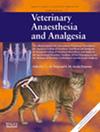Novel ryanodine receptor 1 (RYR1) missense gene variants in two pet dogs with fatal malignant hyperthermia identified by next-generation sequencing
IF 1.4
2区 农林科学
Q2 VETERINARY SCIENCES
引用次数: 0
Abstract
Objective
Evaluate a precision medicine approach to confirm a tentative diagnosis of fatal malignant hyperthermia (MH) in isoflurane-anesthetized pet dogs by identifying novel risk variants in known MH susceptibility genes.
Study design
Retrospective case series.
Animals
A male Pit Bull mix aged 7 years (case #1), a male Golden Retriever aged 12 months (case #2) and the dam and sire of case #2.
Methods
Available case histories and medical records were reviewed. Missense variants in MH susceptibility genes RYR-1, CACNA1S and STAC3 (case #2 only) were identified by next-generation sequencing of DNA from each case and the parents of case #2 with confirmation by Sanger sequencing. The pathogenicity of variants was evaluated by multiple in silico approaches.
Results
Both cases demonstrated clinical signs during isoflurane anesthesia consistent with volatile anesthetic-induced MH, including tachypnea, tachycardia, severe hyperthermia and muscle rigidity. Despite whole body cooling and other treatments, both dogs died after cardiac arrest within 15 minutes of detecting hyperthermia. Gene sequencing identified novel missense RYR-1 variants in case #1 (p.Gly2375Arg) and case #2 (p.Pro152Leu). Both variants were likely pathogenic based on multiple criteria, including gene location, amino acid alteration and population allele frequency. The case #1 variant was identical to a known human diagnostic MH variant (p.Gly2375Arg). Neither parent of case #2 had the case #2 variant, indicating this variant was not inherited, but arose de novo in a germ cell of either parent or early in embryogenesis. Whole genome sequence analysis confirmed parentage. Two missense variants were identified in CACNA1S. Both variants were considered nonpathogenic. No variants were identified in STAC3.
Conclusions and clinical relevance
Like humans, MH susceptibility in dogs is associated with different rare variants located in pathogenic hotspots in the RYR-1 gene. Next-generation sequencing is a useful tool to assist in the definitive diagnosis of MH in dogs.
通过下一代测序发现两只患有致命恶性高热症的宠物狗体内的新型雷诺丁受体 1 (RYR1) 错义基因变异。
目的:通过识别已知恶性高热惊厥易感基因中的新风险变异,评估一种精准医疗方法,以确诊异氟醚麻醉宠物狗中致命性恶性高热惊厥(MH)的初步诊断:回顾性病例系列:一只 7 岁的雄性混合比特斗牛犬(1 号病例)、一只 12 个月的雄性金毛寻回猎犬(2 号病例)以及 2 号病例的母犬和父犬:方法:回顾现有病史和医疗记录。通过对每个病例和 2 号病例父母的 DNA 进行下一代测序,并通过桑格测序确认,确定了 MH 易感基因 RYR-1、CACNA1S 和 STAC3(仅 2 号病例)中的错义变体。变异体的致病性通过多种硅学方法进行了评估:结果:两个病例在异氟醚麻醉期间都出现了与挥发性麻醉剂诱发的 MH 一致的临床症状,包括呼吸急促、心动过速、严重高热和肌肉僵硬。尽管进行了全身降温和其他治疗,但两只狗都在发现高热后15分钟内因心脏骤停而死亡。基因测序在病例 1(p.Gly2375Arg)和病例 2(p.Pro152Leu)中发现了新型错义 RYR-1 变异。根据基因位置、氨基酸改变和群体等位基因频率等多项标准,这两个变异体都可能是致病的。病例 1 的变异与已知的人类 MH 诊断变异(p.Gly2375Arg)相同。2 号病例的父母都没有 2 号病例的变异体,这表明该变异体不是遗传的,而是在父母双方的生殖细胞中或在胚胎发生早期从新产生的。全基因组序列分析证实了父子关系。在 CACNA1S 中发现了两个错义变体。这两个变异都被认为是非致病性的。在 STAC3 中未发现变异:与人类一样,狗的 MH 易感性也与位于 RYR-1 基因致病热点的不同罕见变异有关。下一代测序是协助确诊犬 MH 的有用工具。
本文章由计算机程序翻译,如有差异,请以英文原文为准。
求助全文
约1分钟内获得全文
求助全文
来源期刊

Veterinary anaesthesia and analgesia
农林科学-兽医学
CiteScore
3.10
自引率
17.60%
发文量
91
审稿时长
97 days
期刊介绍:
Veterinary Anaesthesia and Analgesia is the official journal of the Association of Veterinary Anaesthetists, the American College of Veterinary Anesthesia and Analgesia and the European College of Veterinary Anaesthesia and Analgesia. Its purpose is the publication of original, peer reviewed articles covering all branches of anaesthesia and the relief of pain in animals. Articles concerned with the following subjects related to anaesthesia and analgesia are also welcome:
the basic sciences;
pathophysiology of disease as it relates to anaesthetic management
equipment
intensive care
chemical restraint of animals including laboratory animals, wildlife and exotic animals
welfare issues associated with pain and distress
education in veterinary anaesthesia and analgesia.
Review articles, special articles, and historical notes will also be published, along with editorials, case reports in the form of letters to the editor, and book reviews. There is also an active correspondence section.
 求助内容:
求助内容: 应助结果提醒方式:
应助结果提醒方式:


